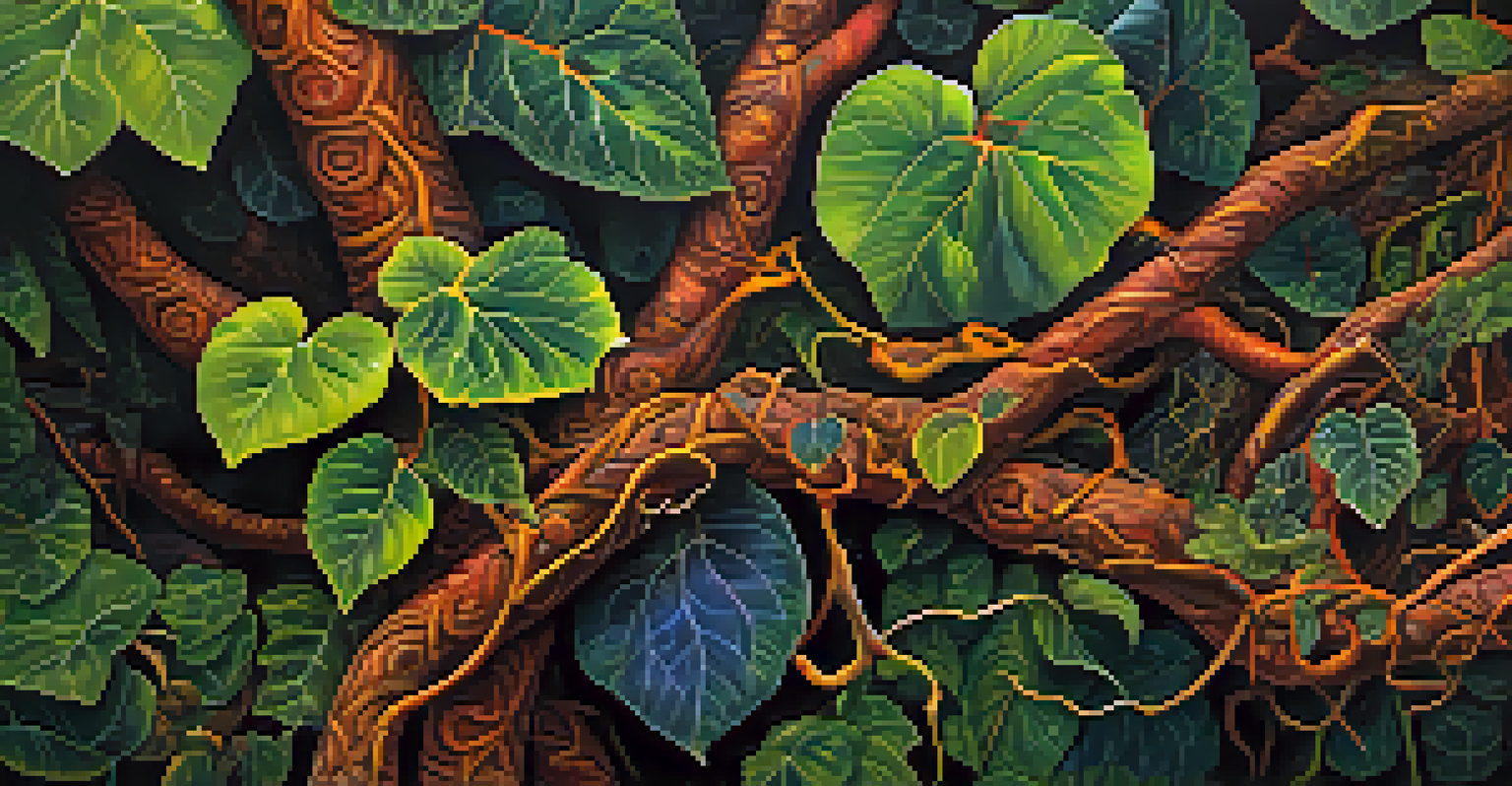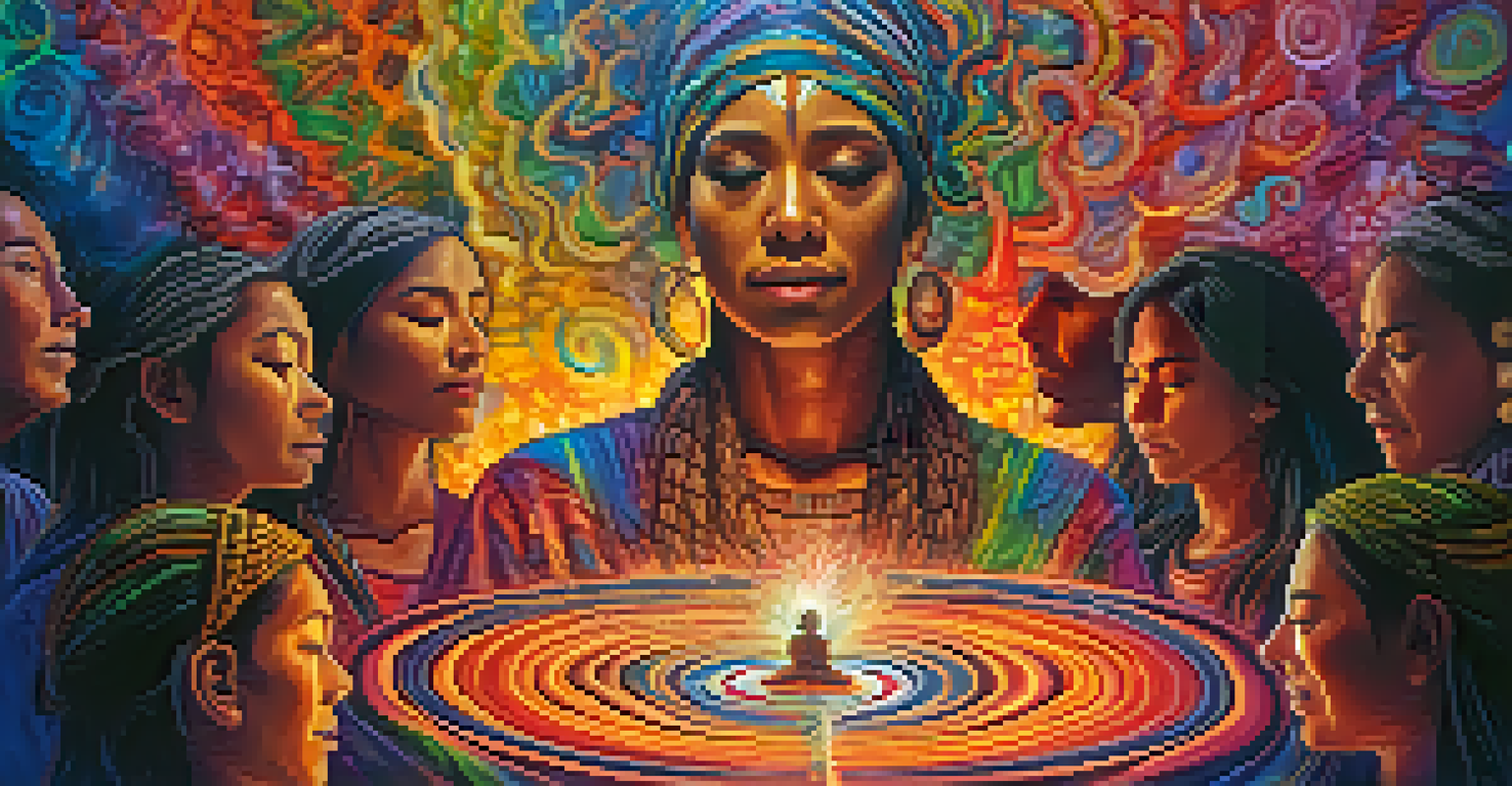Ayahuasca: A Path to Deep Somatic Awareness and Healing

What is Ayahuasca and Its Cultural Roots?
Ayahuasca is a powerful brew made from the Banisteriopsis caapi vine and other plants, traditionally used by Indigenous tribes in the Amazon for centuries. This sacred drink is known for its psychoactive properties, which can lead to profound spiritual experiences and insights. In these cultures, Ayahuasca is often regarded as a teacher, guiding individuals on their journey toward healing and self-discovery.
The experience of Ayahuasca is a journey into the self, a way to confront our deepest fears and hidden emotions.
The preparation and consumption of Ayahuasca are steeped in ritual and ceremony, often led by experienced shamans who facilitate the experience. These rituals not only honor the plant's spirit but also create a safe environment for participants to explore their inner selves. This deep-rooted cultural significance adds layers of meaning to the Ayahuasca experience, transforming it into a communal act of healing.
As awareness of Ayahuasca spreads globally, it has attracted diverse individuals seeking healing for various issues, from trauma to addiction. The blend of ancient wisdom and modern curiosity has positioned Ayahuasca as a unique tool for personal transformation, inviting people to reconnect with their bodies and emotions.
The Role of Somatic Awareness in Healing
Somatic awareness refers to the recognition of bodily sensations and emotions, allowing individuals to connect with their physical selves. This practice can be essential in healing, as many traumas are stored in the body, often manifesting as physical pain or emotional distress. By cultivating somatic awareness, individuals can learn to listen to their bodies, understanding the messages they convey.

In the context of Ayahuasca, participants often report heightened bodily awareness during the experience, prompting them to confront and process suppressed emotions. This process can lead to catharsis, releasing pent-up feelings and fostering a sense of relief. The journey through Ayahuasca can transform how one perceives their body, turning it from an object of discomfort into a source of wisdom and healing.
Ayahuasca's Healing Cultural Roots
Ayahuasca, traditionally used by Indigenous tribes, is a sacred brew known for its psychoactive properties that facilitate spiritual healing and self-discovery.
As individuals develop a deeper connection with their somatic experiences, they may find that their overall emotional and physical health improves. This newfound awareness can lead to healthier coping mechanisms and a more profound understanding of oneself, paving the way for lasting change even after the Ayahuasca experience has ended.
How Ayahuasca Facilitates Emotional Release
One of the most powerful aspects of the Ayahuasca experience is its ability to facilitate emotional release. Participants often find that the brew brings repressed emotions to the surface, allowing them to confront and process feelings they may have buried for years. This purging can be both a physical and emotional experience, often described as a cathartic journey.
Healing is not linear; it's a spiral, and Ayahuasca can help us navigate that spiral with grace and insight.
During an Ayahuasca ceremony, individuals may experience intense visions or memories that trigger deep emotional responses. These moments can be challenging but ultimately lead to a profound sense of relief and healing as participants confront their pain. The shaman's guidance during these times can help individuals navigate their experiences safely and effectively, ensuring a supportive environment for emotional exploration.
The emotional release experienced during Ayahuasca ceremonies can result in a renewed sense of clarity and purpose. As participants let go of old wounds, they may find themselves more open to new possibilities, relationships, and experiences, fostering a transformative journey toward healing.
Integrating the Ayahuasca Experience into Daily Life
After an Ayahuasca ceremony, integration becomes crucial for sustaining the healing process. This involves taking the insights gained during the experience and applying them to everyday life. Participants often find that journaling, meditation, or engaging in discussions with trusted friends can help solidify their newfound understanding and emotional clarity.
Integration is not just about reflecting on the experience; it’s also about making conscious choices that align with the lessons learned. This may mean adopting healthier habits, setting boundaries, or pursuing new interests that resonate with one’s authentic self. By actively engaging in the integration process, individuals can turn their Ayahuasca experience into a catalyst for lasting change.
Importance of Somatic Awareness
Cultivating somatic awareness during Ayahuasca experiences helps individuals confront suppressed emotions and fosters a connection between physical sensations and emotional health.
Support groups or therapy can also play a significant role in the integration journey. Sharing experiences with others who have undergone similar journeys can foster a sense of community and understanding, reinforcing the healing that began during the ceremony. Ultimately, integration allows the teachings of Ayahuasca to take root, enabling individuals to live more fulfilling lives.
Potential Risks and Considerations with Ayahuasca
While Ayahuasca offers many benefits, it's essential to approach it with caution and awareness of potential risks. The brew can induce intense psychological experiences, which may be overwhelming or frightening for some individuals. It’s crucial to consider personal mental health history and consult with experienced practitioners before embarking on an Ayahuasca journey.
Additionally, Ayahuasca can interact with certain medications, particularly antidepressants or other psychoactive drugs. This interaction can lead to dangerous side effects, making it vital for individuals to disclose their medical history fully. A responsible approach includes seeking guidance from knowledgeable facilitators who can assess readiness and safety for participation.
Ultimately, understanding the potential risks associated with Ayahuasca empowers individuals to make informed decisions about their healing journey. By prioritizing safety and preparation, participants can create a supportive foundation for exploring the depths of their consciousness and healing.
The Science Behind Ayahuasca and Healing
Recent studies have begun to explore the scientific underpinnings of Ayahuasca's healing properties. Researchers are investigating how the brew's active compounds, such as DMT (dimethyltryptamine) and harmine, impact the brain and promote emotional healing. These compounds may facilitate neuroplasticity, the brain's ability to reorganize itself, allowing for new patterns of thought and behavior.
Moreover, the experience of Ayahuasca often leads to altered states of consciousness, which can provide fresh perspectives on personal struggles. Many participants describe feeling a sense of interconnectedness with others and the universe, which can foster feelings of empathy and compassion. This shift in perspective can be instrumental in healing emotional wounds and enhancing well-being.
Safe Integration Post-Ceremony
Integrating insights gained from Ayahuasca ceremonies into daily life is crucial for sustaining healing and promoting personal transformation.
As the scientific community continues to investigate the benefits of Ayahuasca, there's hope that this ancient practice can be integrated into modern therapeutic approaches. By bridging the gap between traditional wisdom and scientific research, we can better understand how Ayahuasca can contribute to emotional and psychological healing.
Finding the Right Setting for Ayahuasca Ceremonies
Choosing the right setting for an Ayahuasca ceremony is crucial for a safe and transformative experience. Participants should seek reputable facilitators who prioritize safety and create a nurturing environment. Researching the background and experience of the shaman or guide is essential, as their knowledge can significantly impact the journey.
A supportive environment often includes a comfortable space, appropriate music, and a small group of participants. This setting allows individuals to feel secure, enabling them to dive deep into their emotional and spiritual exploration. Additionally, facilitators should provide pre-ceremony guidance, preparing participants for what to expect and ensuring they understand the process.

Lastly, it's essential to trust your intuition when selecting a ceremony. Each person's experience with Ayahuasca is unique, and finding a setting that resonates with you can enhance the journey. By prioritizing safety, comfort, and intuition, individuals can maximize the potential for healing and self-discovery during their Ayahuasca experience.